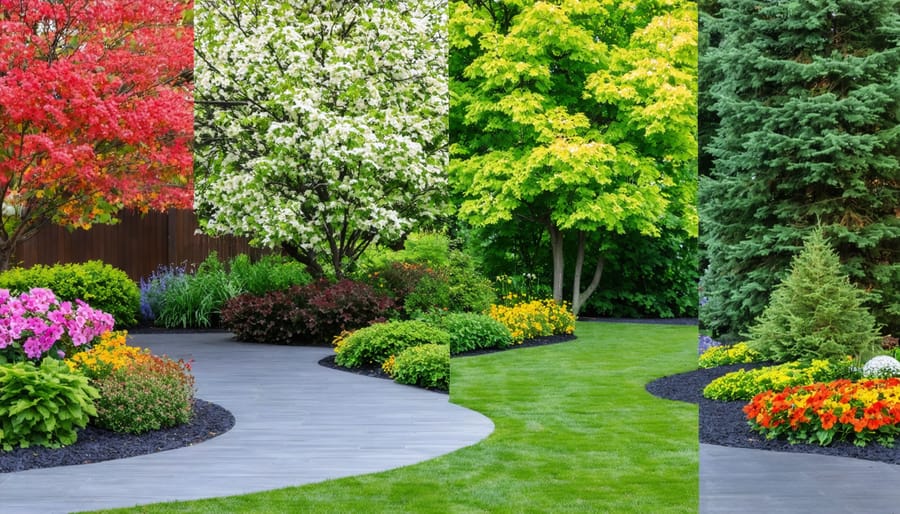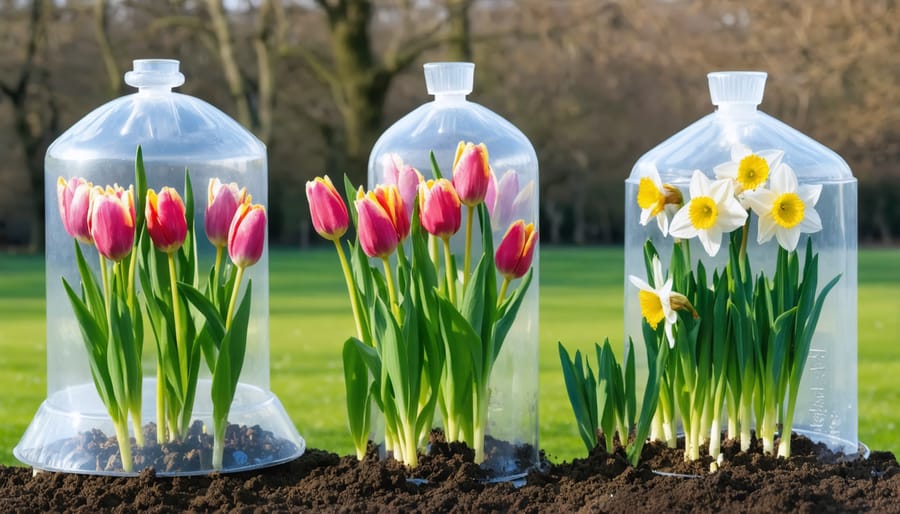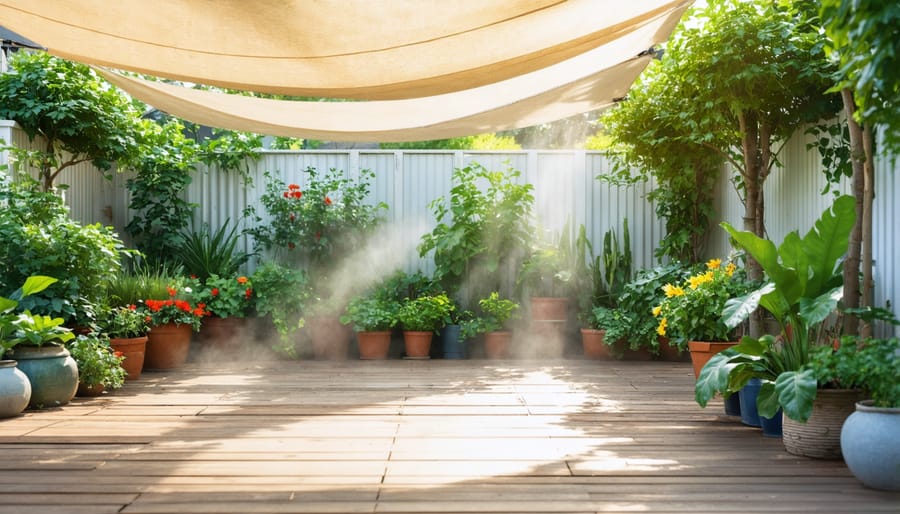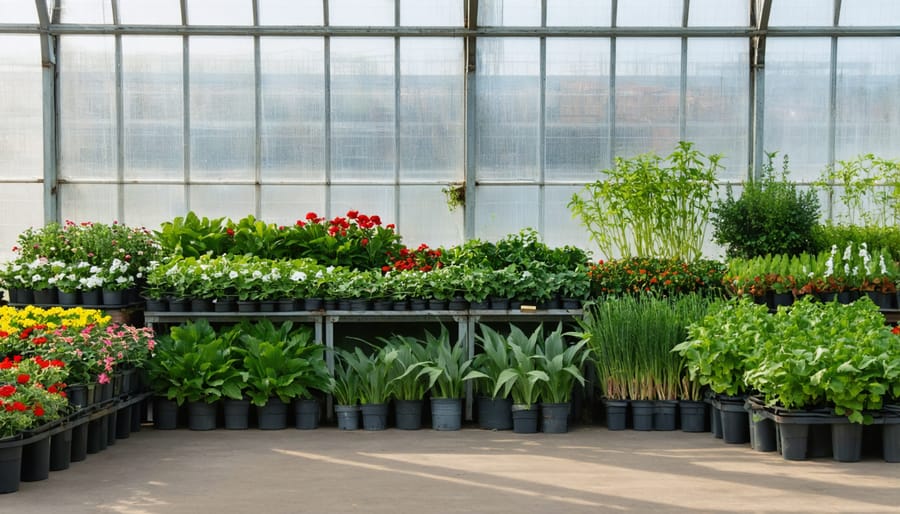Smart Seasonal Plant Storage: Keep Your Garden Thriving Year-Round

Transform your outdoor space year-round with strategic plant selection and seasonal storage solutions that maximize growth and survival. Select cold-hardy perennials like coneflowers and black-eyed susans for continuous blooming from spring through fall, while incorporating evergreen shrubs such as boxwood and holly for year-round structure. Group plants with similar water and sunlight needs together, creating efficient maintenance zones that adapt to changing weather patterns. Plant spring bulbs in fall, summer annuals after the last frost, and autumn mums in late summer to maintain continuous color and interest throughout the growing season. Protect tender perennials with thick mulch layers before winter, and use portable containers for sensitive plants that need indoor protection during extreme weather. This systematic approach ensures your garden remains vibrant and healthy across all seasons while minimizing maintenance requirements and plant loss.
Spring Plants: Protection During Late Frost
Early Bloomers and Their Needs
Early spring bloomers like crocuses, daffodils, and tulips require special attention to thrive year after year. These hardy plants need consistent temperature monitoring to protect them from late frosts. It’s essential to monitor outdoor temperatures carefully, especially during those unpredictable early spring days.
For successful storage and protection, keep bulbs in a cool, dry place during their dormant period. A well-ventilated garden shed with adjustable shelving works perfectly for this purpose. Arrange bulbs in single layers in breathable containers, such as wooden crates or mesh bags, to prevent moisture buildup and potential rot.
Delicate early bloomers like hellebores and primroses benefit from temporary protective coverings during frost warnings. Keep frost blankets and portable cold frames readily accessible in your storage space. Having these items organized and within reach can make the difference between losing your early blooms and enjoying their full display.
Consider creating a designated area in your shed for spring gardening supplies, including plant markers, protective materials, and seasonal tools. This organization helps ensure you’re prepared when these early risers start pushing through the late winter soil.
Temporary Storage Solutions
When temperatures drop or seasons change, protecting your spring plants becomes crucial for their survival. A well-planned temporary storage solution can make the difference between thriving plants and lost investments. For container plants, consider using a portable greenhouse or cold frame, which provides shelter while maintaining essential light exposure. These structures can be easily assembled and dismantled as needed.
Unheated garages and basements offer excellent protection for dormant plants, provided they maintain temperatures between 35-45°F. Place plants on elevated platforms or shelves to ensure proper air circulation and prevent moisture buildup. For smaller plants, clear storage bins with ventilation holes work wonderfully, creating mini-greenhouses that protect against frost while allowing light penetration.
Don’t overlook the power of mulching and wrapping. Layer mulch around plant bases and use burlap or frost blankets for additional protection. Many gardeners successfully use bubble wrap around pots to insulate roots, particularly effective for container plants too large to move indoors.
Remember to check stored plants regularly for signs of disease or pest problems. Maintain minimal watering during storage periods – just enough to prevent roots from completely drying out. With proper temporary storage, your spring plants can weather the challenging seasons and return vibrant when conditions improve.

Summer Plant Management
Heat-Sensitive Plants
While many plants thrive in summer sunshine, some delicate varieties need extra protection during intense heat waves. Tender plants like hostas, ferns, and impatiens can quickly become stressed when temperatures soar, showing signs like wilting leaves and scorched edges.
To protect these heat-sensitive plants, consider creating shade zones using umbrellas, shade cloth, or strategically placed taller plants. Container plants are particularly vulnerable, as their roots can heat up quickly. Moving them to shadier spots during peak afternoon hours can prevent damage. Popular heat-sensitive varieties that benefit from protection include:
– Hydrangeas (especially in full sun)
– Japanese Forest Grass
– Bleeding Hearts
– Coral Bells
– Lady’s Mantle
Monitoring soil moisture is crucial, as heat-sensitive plants often need more frequent watering. Apply a thick layer of mulch around these plants to help retain moisture and keep root zones cool. During extreme heat waves, consider using temporary shade structures or moving container plants to covered areas.
Morning watering is best for these delicate plants, giving them time to absorb moisture before the day’s heat intensifies. If you notice signs of heat stress, such as curling leaves or brown edges, increase watering frequency and provide additional shade until temperatures moderate.
Shade Solutions and Storage
Protecting your seasonal plants from harsh sunlight and having proper storage solutions are essential for maintaining a thriving garden. Creating shade doesn’t have to be complicated – portable umbrellas, shade sails, and retractable awnings offer flexible protection that can be adjusted as the sun moves throughout the day.
For smaller plants, consider using pop-up greenhouse tents or shade cloth structures that can be easily assembled and dismantled as needed. These temporary solutions are perfect for protecting sensitive plants during peak summer hours while allowing proper airflow and maintaining aesthetic appeal.
Storage is equally important for maintaining your gardening supplies and protecting plants during extreme weather. Weather-resistant deck boxes serve double duty as both seating and storage space for gardening tools, while vertical garden organizers maximize space efficiency in tight areas. For seasonal transitions, rolling plant caddies make it easy to move heavy containers between indoor and outdoor spaces.
Smart storage solutions should include dedicated spaces for different categories: tools, soil and amendments, seasonal decorations, and emergency protection materials. Consider installing wall-mounted tool racks or utilizing corner spaces with triangular shelving units. Many gardeners find success with modular storage systems that can be expanded or reconfigured as their needs change throughout the seasons.
Remember to keep frequently used items easily accessible while storing seasonal items in weather-protected areas. A well-organized storage system not only protects your investments but also makes gardening more enjoyable and efficient.

Fall Transition Strategies
Pre-Winter Preparation
As winter approaches, taking the right steps to protect your outdoor plants is crucial for successful year-round garden maintenance. Start by thoroughly inspecting your plants for signs of disease or pest infestations, addressing any issues before storage. Trim back perennials to about 6 inches above ground level, removing dead or damaged foliage that could harbor problems during winter months.
For container plants, clean the pots thoroughly and move them to a protected area like a shed or garage where temperatures remain above freezing. If you’re keeping plants outdoors, apply a thick layer of mulch around the base to insulate roots. Consider using burlap wrapping for sensitive shrubs and young trees to shield them from harsh winds and frost damage.
Create an inventory of your stored plants and label everything clearly – this will help you track their needs throughout winter. Group plants with similar water requirements together to simplify care routines. Remember to gradually reduce watering as temperatures drop, but don’t let plants dry out completely.
For bulbs and tubers, wait until the first frost kills the foliage, then dig them up carefully. Clean off excess soil, let them dry for a few days, and store in paper bags filled with peat moss or vermiculite. Keep these in a cool, dry place with good air circulation until spring planting time.
Storage Structure Options
Protecting your seasonal plants requires reliable storage solutions, and choosing the right structure can make all the difference in keeping your garden thriving year-round. Greenhouses offer the perfect environment for delicate plants, providing controlled temperature and humidity levels while allowing natural light to penetrate. They’re particularly valuable for extending growing seasons and nurturing tender plants through winter months.
Storage sheds present a versatile option for storing dormant plants, gardening tools, and seasonal containers. When selecting a shed, consider features like ventilation panels and adjustable shelving to accommodate different plant sizes. A well-organized shed with proper airflow can protect bulbs, tubers, and other underground storage organs during their dormant period.
For those with limited space, lean-to structures and cold frames serve as excellent alternatives. These compact options attach to existing walls or fences, maximizing available space while providing essential protection for your plants. Cold frames work particularly well for hardening off seedlings and protecting semi-hardy plants during transitional weather.
Whatever structure you choose, ensure proper insulation and moisture control. Adding thermal blankets during extreme weather and installing humidity monitors can help maintain optimal conditions. Remember to position your storage structure in a location that balances sunlight exposure with protection from harsh elements, and consider adding automatic ventilation systems for hassle-free maintenance.
Winter Protection Methods
Cold-Hardy vs. Sensitive Plants
When it comes to storing seasonal plants, understanding whether your plants are cold-hardy or sensitive is crucial for their survival. Cold-hardy plants like hostas, daylilies, and native perennials can typically remain in the ground throughout winter, protected by a thick layer of mulch. These resilient plants have natural mechanisms to withstand freezing temperatures and will bounce back when spring arrives.
Sensitive plants, however, require more careful attention. Tropical plants, tender bulbs, and exotic varieties need protection from frost and freezing temperatures. These plants should be moved indoors or to a sheltered area before the first frost. For container plants, consider transferring them to a garage, basement, or greenhouse where temperatures remain above freezing. Some bulbs, like dahlias and cannas, can be dug up, cleaned, and stored in paper bags with peat moss until spring.
Remember that even cold-hardy plants may need extra protection in extreme conditions. Using frost blankets, cold frames, or mulch can provide that additional layer of security during particularly harsh winters.
Indoor Storage Tips
When winter approaches, proper indoor storage becomes crucial for protecting your sensitive outdoor plants. Start by thoroughly cleaning and inspecting each plant for pests before bringing them inside. Choose a bright location away from drafty windows and heating vents, as sudden temperature changes can stress your plants. If space is limited, consider ways to organize your garden space by using vertical shelving or hanging planters.
Maintain consistent humidity by placing plants on pebble trays filled with water or using a humidifier nearby. Reduce watering frequency during winter months, as most plants enter a period of dormancy. Check soil moisture by inserting your finger about an inch deep – only water when the soil feels dry at this depth.
For bulbs and tubers, store them in paper bags filled with dry peat moss or vermiculite in a cool, dark place around 40-50°F. Label everything clearly to avoid confusion come spring. Remember to periodically check stored plants for signs of disease or decay, removing any affected parts promptly to prevent spread.

Outdoor Storage Solutions
When winter approaches, outdoor storage structures become essential safeguards for your seasonal plants. A well-organized shed or greenhouse can protect delicate plants from frost while providing easy access for maintenance. Consider installing adjustable shelving in your storage space to maximize vertical space and accommodate plants of different sizes. For smaller spaces, wall-mounted racks and hanging systems work wonders for storing dormant plants and gardening tools.
Insulation plays a crucial role in winter plant storage. Line your shed walls with bubble wrap or specialized insulation materials, and use thermal curtains over windows to maintain consistent temperatures. Place sensitive plants on raised platforms to prevent cold transfer from the ground, and group them together to create beneficial microclimates.
Remember to maintain proper ventilation even during cold months. Install adjustable vents or small fans to prevent moisture buildup, which can lead to mold and disease. For unheated structures, consider adding a small space heater with a thermostat for extremely cold nights. Keep plants in containers that can be easily moved in and out as temperatures fluctuate, and always monitor weather forecasts to anticipate when additional protection might be needed.
Proper care and storage of seasonal outdoor plants is crucial for maintaining a vibrant and healthy garden throughout the year. As we’ve explored, each season brings unique challenges and opportunities for plant care, making thoughtful storage solutions essential for both plant health and garden organization.
Remember that successful seasonal plant management relies on three key principles: timing, protection, and proper storage conditions. Whether you’re storing delicate summer bulbs during winter months, protecting spring seedlings from late frosts, or maintaining fall perennials, having the right storage setup can make all the difference in your plants’ survival and thriving potential.
Taking the time to prepare your storage spaces before each seasonal transition will save you both time and money in the long run. By protecting your plants from extreme temperatures, excess moisture, and pest damage, you’re investing in next season’s garden success. Consider creating a seasonal maintenance calendar to track when different plants need to be moved, stored, or brought back out into the garden.
Don’t forget that proper storage extends beyond just protecting plants – it’s about creating an organized system that makes seasonal transitions smoother and more efficient. When your tools, containers, and plant materials are well-organized and properly stored, you’ll find yourself better equipped to handle whatever challenges each season brings to your garden.
With these practices in place, you’ll be well-prepared to nurture your outdoor plants through every season, ensuring they return year after year in their full glory.

